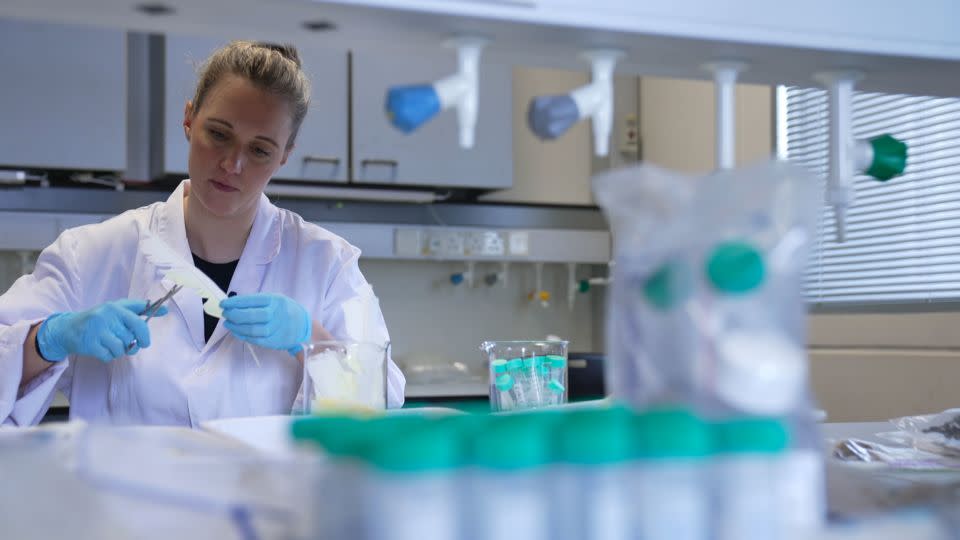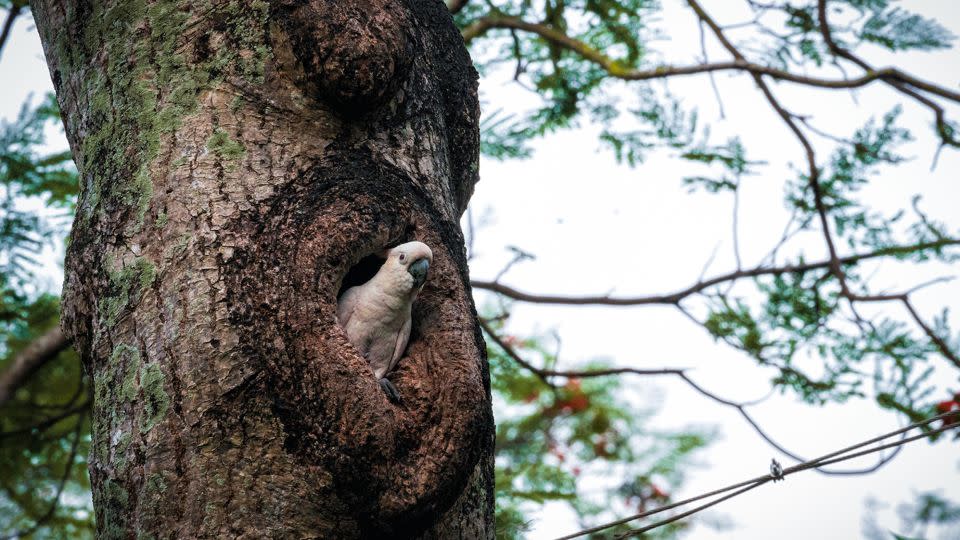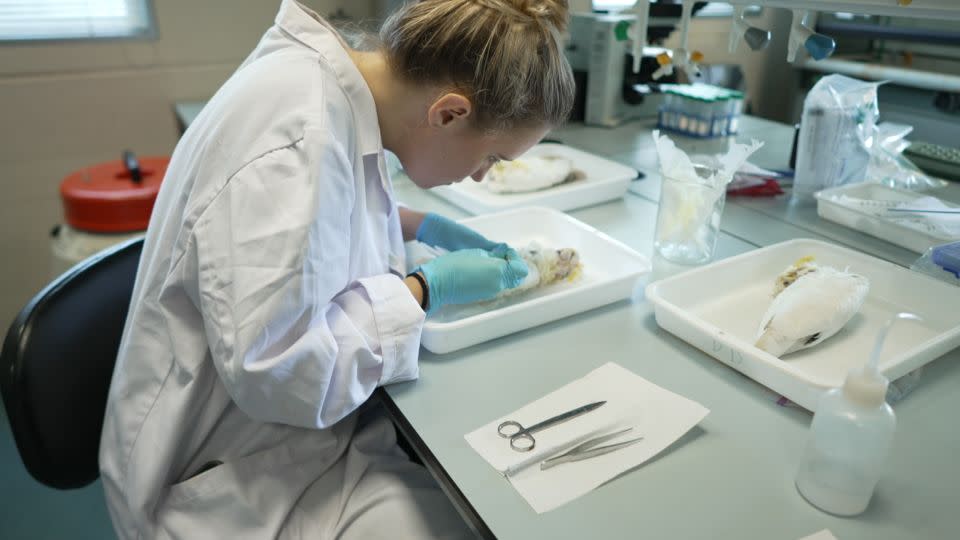Poaching has decimated the numbers of this rare cockatoo. Could a feral flock in Hong Kong save the species?
Editor’s Note: Call to Earth is a CNN editorial series committed to reporting on the environmental challenges facing our planet, together with the solutions. Rolex’s Perpetual Planet initiative has partnered with CNN to drive awareness and education around key sustainability issues and to inspire positive action.
It’s dusk in Hong Kong Park. Taxis screech past on the road outside, the shuffling footfall of commuters meandering home as the leaves rustle in the evening breeze, and then –
SQUAWK.
It’s a sound somewhere between a hoarse car alarm and a braying donkey. Barely visible through the foliage from ground level, the source of the racket sits in the upper branches of a decades-old cotton tree. Snow-white feathers topped with a regal yellow crest, and a pale marigold blush on its cheeks below cartoonishly wide eyes: this is the yellow-crested cockatoo.
To some, these screeching birds are a noisy nuisance. But to Astrid Andersson, a Swedish-born, Hong Kong-raised postdoc researcher in the University of Hong Kong’s conservation forensics laboratory, they’re a story of survival.
“(It) shows that humans and wildlife can coexist, even in highly developed areas,” she says.
Yellow-crested cockatoos were once widespread in the rainforests of Indonesia and Timor Leste. But soaring demand for the mischievous birds as pets in the 20th century saw tens of thousands taken from the wild, with up to 96,000 birds exported between 1981 and 1992.
Many of these birds were imported into Hong Kong, where they escaped or were released. Now critically endangered, it’s believed that between 1,200 and 2,000 mature individuals remain in the wild – and Hong Kong’s feral population accounts for around 10%.
“With the numbers in Indonesia dwindling, and subject to pressures like climate change, habitat loss and ongoing trapping, the population in Hong Kong represents a safe haven – a population that is removed from those threats,” says Andersson.
Quadrupling in numbers since the 1970s, “the population in Hong Kong could potentially have an important role in the conservation of yellow-crested cockatoos worldwide,” says Andersson.
But even these cockatoos aren’t entirely out of harm’s way.
Legal loopholes
Andersson began researching the yellow-crested cockatoos in 2016, to explore the “multiple issues that impact traded species.”
“Hong Kong is a thoroughfare for legal wildlife trade – everything from reptile skins to exotic pets, to seafood – and that provides a cover for the illegal wildlife trade as well to operate in parallel,” says Andersson.
As part of her PhD research, Andersson conducted weekly surveys at Hong Kong’s bird market where she would often see yellow-crested cockatoos for sale.
While the cockatoos are listed under Convention on International Trade in Endangered Species (CITES) Appendix 1, which bans their commercial trade, there is a “gray area where cockatoos can be traded if they’ve come from a captive breeding facility,” says Andersson. “However, you can’t enforce that because you can’t tell which ones have come from the wild illegally, or which ones are actually from a breeding facility, just using your eyes.”
According to a spokesperson for the government’s Agricultural, Fisheries and Conservation Department (AFCD), “the last import of a yellow-crested cockatoo for commercial purposes was in 2004,” and currently, there is no CITES-registered breeding operation or valid license for the possession of a yellow-crested cockatoo for commercial purposes in the city.
“There is no record-keeping for the home breeding, so we don’t know, if any, how much home breeding of yellow-crested cockatoo is actually going on here in Hong Kong,” says Andersson.

Driven by demand from the exotic pet trade, Andersson says were reports of poaching in Hong Kong during her PhD. So Andersson developed a method using “stable isotope analysis” to evaluate the carbon and nitrogen in feathers, which reflect the bird’s diet, to help spot wild versus captive birds.
While wild cockatoos eat a variety of leaves, shoots, flowers and fruits, captive birds are often fed a diet high in corn, which has a very distinctive carbon ratio, she says, adding that the test yields results in just one week, and is inexpensive.
“You could apply it to cockatoos in the market to test if they have recently been taken from the wild,” says Andersson.
Fox in the henhouse
The wildlife trade isn’t just a problem for the yellow-crested cockatoos. Hong Kong, despite its urban sprawl and concrete veneer, is a stronghold for several endangered species, including Chinese pangolins, Hong Kong groupers, and the black-faced spoonbill.
It’s also the last safe haven for three globally threatened freshwater turtle species, which just like the cockatoos, have been over-exploited in the wild. But continued poaching activity in Hong Kong is shattering conservationists’ hopes of being able to use this population to reintroduce the turtles elsewhere.
Wildlife crime was reclassified in Hong Kong in 2021, giving law enforcement greater investigative power and the ability to implement rules. According to the AFCD, it uses a “series of measures that aim at curbing smuggling of endangered species and strengthening the control of local trade,” including sniffer dogs and cross-border intelligence exchanges.
However, recent research highlights that a lack of regulatory safeguards in the legal trade allows unethical or downright illegal activity to go unnoticed.
Hong Kong is the world’s biggest wildlife trading hub. A 2022 report by environmental impact research firm ADM Capital Foundation (to which Andersson contributed) found that between 2015 and 2019, up to four million animals were legally imported for the exotic pet trade, and of the 700 different species imported, 70% were threatened with extinction. Hong Kong imported more CITES-protected species for trade than any other country or territory over this period – including the rest of Mainland China combined.
Bird’s eye view
There are multiple layers of problems for regulators to address, says Fiona Woodhouse, deputy director of welfare at the Society for the Prevention of Cruelty to Animals (SPCA) in Hong Kong.
The trade of endangered animals poses an obvious ethical dilemma, but Woodhouse notes that even species that aren’t endangered “can very rapidly become endangered when you are removing large numbers from the native populations.” Additionally, the presence of wild populations in an area where a species is traded “blurs the line,” says Woodhouse, leaving “a lot of room for smuggling and poaching.”
Related: This zoo is breeding hope for endangered species
Captive-bred cockatoos are supposed to be tagged with a leg band or marking which indicates where the bird came from, which makes “cockatoos from illegal source readily distinguishable upon inspection,” according to the AFCD. But neither Woodhouse nor Andersson think the ID rings system is robust enough to prevent wild animals from being passed off as captive-bred.
When CNN visited Hong Kong’s Yuen Po Bird Market in May 2023, we were told that the only yellow-crested cockatoos on display were “pet” cockatoos – but after enquiring about where to purchase one, some shopkeepers claimed they could source a yellow-crested cockatoo for HKD28,000, around $3,500.
(These shopkeepers declined to be interviewed for this story, while the Leisure and Cultural Services Department, responsible for the landscaping and facilities, told CNN in a statement that it does not oversee the management of individual stalls. The AFCD told CNN, “The AFCD conducts market inspections, online trading platform surveillance and intelligence collection, so as to monitor suspected illegal trade in species scheduled under the Ordinance. Stringent enforcement actions will be taken if irregularities are detected.”)
While the pet shops are tightly regulated, there’s little oversight in the private pet owner trade, which has also moved online in recent years. “Now, you don’t have to go to a wildlife market, you do it on Facebook. So there’s less opportunities for law enforcement unless you’re managing to get inside and do undercover investigations,” says Woodhouse, adding that the fines are also small in comparison to the potential profit of selling the birds. For example, one yellow-crested cockatoo can sell for 46% more than the median Hong Kong monthly salary.
Other NGOs in the city have also seen commercial trading activity of the birds. WWF-Hong Kong conducts surveys of the bird market a few times a year, and at its last survey in February 2023, the team saw yellow-crested cockatoos for sale, says Jovy Chan, wildlife conservation manager at WWF-Hong Kong.
“We can see a few shops selling yellow-crested cockatoos on and off,” says Chan in an email. Additionally, WWF-Hong Kong monitors online groups, and has seen people selling offspring. “They may ask people to send a private message, or they may use some hidden keywords to disclose the price, for example, stating the flying distance of the bird,” she adds.

DNA deep-dive
In the University of Hong Kong’s biology lab, Andersson sets a basket of cockatoo carcasses wrapped in Ziploc bags on the worktop. “I’m so glad you guys are down to do this,” she says, sitting down with a scalpel and tweezers.
“This” is watching as Andersson demonstrates exactly how she is working on the next stage of her research: genetic analysis.
While her previous project used just the feathers of the birds, examining their DNA requires tissue samples, hence the dead birds. They all died from natural causes and were found by members of the public, before being handed over for research.
By comparing the DNA of the Hong Kong flock with museum samples of birds from the natural range, Andersson hopes that genetic analysis will reveal details about their origins.
“We can see if these cockatoos have all come from one island or if they are a mixture of cockatoos from different islands in Indonesia,” she says, adding that the cockatoo’s age, genetic health, and whether they’ve been inbreeding are more key questions that need to be answered, to evaluate whether the Hong Kong flock could potentially help the Indonesian one.

The Hong Kong population has blossomed from around 50 in the 1970s to an estimated 200 today, but Andersson says this has stagnated in recent years. While poaching could be contributing to the problem, Andersson says one of the biggest restrictions is a lack of adequate nest sites.
But before the population can be bolstered, the illegal wildlife trade needs to be addressed. If the yellow-crested cockatoos breed successfully, Andersson says the birds will return to the same nest year-on-year. However, if their nesting is interrupted, say by a poacher stealing chicks, the birds will abandon the site. (According to the AFCD, it has “not received any report related to poaching of yellow-crested cockatoos in the past three years.”)
Extremely picky about where they roost, the yellow-crested cockatoos use cavities that form in the trunks of trees that are typically older than 100 years. Hong Kong was deforested extensively during the Second World War, so there’s a short supply of old trees. One solution could be nest boxes that mimic these tree cavities, says Andersson.
She is optimistic that the charismatic bird’s adaptability will help it in the future.
“The cockatoos have been able to survive through all the adversities that they’ve faced,” says Andersson. “They’ve been able to persist in this highly urbanized environment. I think that sends a message of hope, about the survival of species in general on this planet.”
Tom Booth, Noemi Cassanelli, Charlie Stewart, and Woojin Lee, CNN, also contributed to this story
For more CNN news and newsletters create an account at CNN.com

